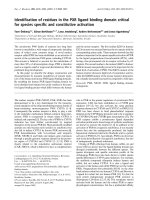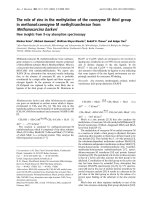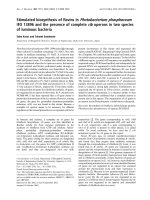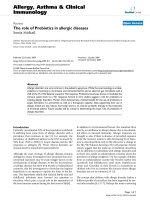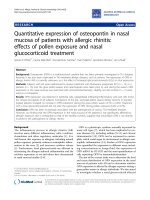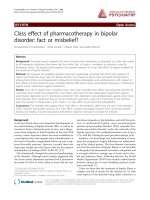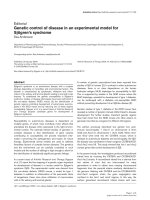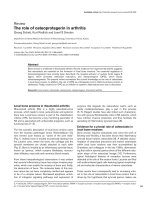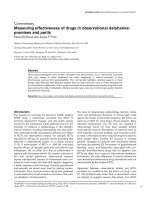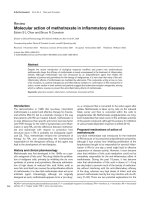Báo cáo y học: "Mechanical induction of cough in Idiopathic Pulmonary Fibrosis" doc
Bạn đang xem bản rút gọn của tài liệu. Xem và tải ngay bản đầy đủ của tài liệu tại đây (1.52 MB, 10 trang )
RESEARCH Open Access
Mechanical induction of cough in Idiopathic
Pulmonary Fibrosis
Richard M Jones
1,5*
, Simon Hilldrup
1
, Benjamin DM Hope-Gill
2
, Ronald Eccles
3
and Nicholas K Harrison
1,4
Abstract
Background: Patients with idiopathic pulmonary fibrosis (IPF) frequently develop a dry, irritating cough which
often proves refractory to anti-tussive therapies. The precise pathogenetic mechanisms responsible for this cough
are unknown. We hypothesised that changes in nerves modulating mechanical sensitivity in areas of interstitial
fibrosis might lead to enhanced cough response to mechanical stimulation of the chest in IPF.
Methods: We studied 27 non-smoking subjects with IPF (63% male), mean (SD) age 71.7 (7) years and 30 healthy
non-smokers. Quality of life (Leicester Cough Questionnaire), cough symptom scores and cough severity scores
(visual analog scales) were recorded. Percussion stimulation was applied over the posterior lung base, upper
anterior chest and manubrium sternum at sequential frequencies (20 Hertz (Hz), 40 Hz and 60 Hz) for up to 60
seconds and repeated twice at two minute intervals. The number of subjects achieving two and five-cough
responses, total cough counts and cough latency were recorded. In separate experiments, the effect of mechanical
stimulation on the pattern of breathing was determined in eight IPF subjects and five control subjects.
Results: In patients with IPF, we demonstrated strong correlations between subjective cough measurements,
particularly the cough symptom score and Leicester Cough Questionnaire (r = -0.86; p < 0.001). Mechanical
percussion induced a true cough reflex in 23/27 (85%) IPF subjects, but only 5/30 (17%) controls (p < 0.001). More
patients with IPF reached the two-cough response at a lower frequency (20 Hz) post eriorly than at other positi ons.
Highest mean cough totals were seen with stimulation at or above 40 Hz. Mechanical stimulation had no effect on
respiratory rate but increased tidal volume in four (50%) subjects with IPF, particularly at higher frequencies. It was
associated with increased urge to cough followed by a true cough reflex.
Conclusions: This study demonstrates that patients with IPF show enhanced cough reflex sensitivity to mechanical
stimulation of the chest wall whilst normal individuals show little or no response. The observation that low
frequency stimulation over the lung base, where fibrosis is most extensive, induces cough in more patients than at
other sites supports the hypothesis that lung distortion contributes to the pathogenesis of cough in IPF.
Background
Idiopathic pulmonary fibrosis (IPF) is a disease charac-
terised by lung parenchymal distortion by fibroblastic
proliferation with extracellular matrix deposition and an
inflammatory cell infiltration. Patients typically present
with progressive breathlessness but the majority develop
an irritating cough during the course of the disease
[1,2]. This cough is typically dry and proves resistant to
conventional anti-tussive therapies [2].
The majority of respiratory diseases associated with
cough, such as chronic bronchitis, asthma and acute
viral infections, predominantly affect the airways or
upper respiratory tract where sensory innervation is
dense. By contrast, pathological ch anges in IPF princi-
pally affect the lung parenchyma and alveoli, where
innervation is sparse. It is therefore surprising that
cough is so common in this disorder. The mechanisms
which cause cough in IPF are unknown but several the-
ories have been proposed [3]. These include modulation
of nerves in larger airways by neurotrophins generated
within diseased lung parenchyma, mechanical lung dis-
tortion from fibrosis altering the activation of cough
receptors and gastro-oesophageal reflux disease
* Correspondence:
1
Respiratory Unit, Morriston Hospital, Heol Maes Eglwys, Swansea, SA6 6NL,
UK
Full list of author information is available at the end of the article
Jones et al. Cough 2011, 7:2
/>Cough
© 2011 Jones et al; licensee BioMed Central Ltd. This is an Open Access article distributed under the terms of the Creative Commons
Attribution License (http://creativecomm ons.org/licenses/by/2.0), which permits unrestricted use, distribution, and reproductio n in
any medium, provided the original work is prop erly cited.
(GORD), which is known to be present in approximately
80% of patients with IPF [4].
Cough reflex sensitivity to chemical stimulation from
inhaled capsaicin and substance P has been shown to be
increased in patients w ith IPF, suggesting functional
upregulation of pulmonary c-fibres [5,6]. However, as
far as we are aware, there have been no studies of the
cough response to mechanical stimulation of the lungs
in IPF.
Crystal et al. [2] reported that 80% of surgical lung
biopsies showing characteristic changes of usual intersti-
tial pneumonia (UIP) had evidence of peribronchiolar
fib rosis and/or inflammation, with the majority of b iop-
sies displaying evidence of both narrowed and dilated
airways. It is therefore possible that mechanical distor-
tion of peripheral airway architecture could sensitise
rapidly adapting receptors (RARs) in small airways
thereby lowering the cough threshold. Alternatively, c-
fibres in the pulmonary interstitium, which have been
reported to inhibit the cough reflex in certain species,
could be destroyed by the progressive fibrotic process
[7,8].
Mechanical stimulation of the throat and trachea has
been shown to induce cough in patients with upper
respiratory tract infection but little or no cough in
healthy subjects [9,10]. In one such study, chest wall
vibration over t he manubrium sternum was performed
using a chest percussor originally developed to assist
clearance of bronchial secretions [10]. This novel techni-
que is potentially a non-invasive and safe method for
inducing mechanical vibration of the underlying lung
and hence physical deformation of s ensory receptors
such as RARs, independent of chemical stimuli.
In this context, the present study was devised with the
following aims:
• To examine whether mechanical stimulation of the
chest wall can induce cough in patients with IPF
and if so, whether this response is reliable and
reproducible.
• To assess whether varying the frequency of vibra-
tion and the site of stimulation induces different pat-
terns of cough in patients with IPF.
• To correlate measures of any cough induced by
mechanical stimulation with subjective measures of
cough assessed by validated questionnaires.
• To determine whether mechanical stimulation of
the chest wall has any effects on the pattern of
breathing in patients with IPF or controls.
Methods
Patients
Twenty seven patients fulfilling the American Thoracic
Society/European Respiratory Society criteria for the
diagnosis of I PF were recruited [11]. All patients had
clinical, radiological and physiological features consistent
with a diagnosis of IPF. In addition, each patient had
undergone high resolution computed tomography
(HRCT) scanning confirming the presence of pulmonary
fibrosis, with predominant reticular or honeycomb pat-
tern in the subpleural regions of the lung bases and little
or no ground glass shadowing. Five patients had also
undergone a surgical lung biopsy which showed the his-
tological pattern of UIP. All patients were either non-
smokers or had not smoked for at l east one year. Exclu-
sion criteria are shown in table 1. Thirty healthy volun-
teers acted as control subjects. No patients or control
subjects with a history of gastro-oesophageal reflux were
included unless they were established on proton pump
inhibitor therapy for at least one month prior to the
study commencement. The Leeds Dyspepsia Question-
naire (LDQ), an eight item symptom-based question-
naire was used to assess the severity of dyspepsia [12].
The possible total score ranges from 0 - 40, with lower
values indicating less and higher values more severe dys-
pepsia. Measurement of pulmonary function was per-
formed according to published guidelines [13]. Ethical
approval was granted by the Local Research Ethics
Committee prior to the study commencing (South West
Wales Research Ethics Committee, reference number
07/WMW02/111) and i nformed written consent was
provided by all subjects. The research was carried out in
accordance with the Helsinki Declaration.
Subjective Assessment of Cough
Three separat e measures of coug h were undertaken. All
subjects were asked to grade their cough severity from 0
(nocough)to100(worstcoughever)usinga100mm
linear visual analogue scale (VAS) [14]. The impact of
cough on quality of life was assessed using the Leicester
Cough Questionnaire (LCQ) [15]. This consists of 19
questions, divided into three domains (social, psycholo-
gical and physical) with a total calculated score ranging
from 3-21, with higher scores indicating less impact on
quality of life. Severity of daytime and night cough
Table 1 Study Exclusion Criteria
1 History of smoking within 1 year
2 Evidence of respiratory tract infection within 6 weeks
3 History of untreated rhino-sinusitis
4 Untreated gastro-oesophageal reflux disease
5 Asthma or other respiratory disease other than IPF
6 History of asbestos exposure
7 History of collagen vascular diseases
8 Other severe, systemic co-morbidity
9 Drug therapy with angiotensin-converting enzyme inhibitors
10 Chest wall deformity precluding mechanical percussion
Jones et al. Cough 2011, 7:2
/>Page 2 of 10
symptoms were also assessed usi ng the cough symptom
score (CSS) (table 2) [16]. Daytime and n ight time
scores were added with a total possible score of ten.
Mechanical cough stimulation
Sub jects underwent mechanical stimulation of the chest
wall using a percussor (G5 Variko; Physiotherapie Gen-
erale, Cast eljaloux, France). A soft sponge rubber appli-
cator (applicato r no. 212/diameter 100 mm and
thick ness 30 mm; Physiotherapie Generale, Casteljaloux,
France) was used to apply the percussor to the chest
wall. Use of a right angle directional stroking adaptor
converted the oscillatory effect produced by the face
plate to an optimal percussive effect with stimulation
frequencies from 20 to 60 Hz (Figure 1). A microphone
connected to a computer recorded sound signals. Man-
ual cough counting was conducted using a digital audio
editing package with an audiovisual display (Audacity
1.2.6 software, Pittsburgh, USA). Cou ghs were identified
as characteristic explosive sounds [17].
Subjects attended the laboratory between 09:00 and
11:00, following abstinence from caffeine-containing
drinks for at least six hours and fasted for at least two
hours. They were asked to sit comfortably on a chair for
a six minute acclimatisation period during which their
spontaneous cough frequency was measur ed and subs e-
quently used to calculate the background cough fre-
quency. Each subject was asked to rotate 90 degrees in
the chair and the percussor was applied with a uniform
pressure, sequentially to the following areas of the chest
wall:
• thebaseoftherightlungintheposterioraxillary
line,
• the anterior right chest over the 2
nd
intercostal
space in the mid-clavicular line and
• over the manubrium sternum.
Using an initial stimulation frequency of 20 Hz, per-
cussionwasappliedforamaximumofoneminutebut
switched off if the subject coughed within the one min-
ute period. Any vibration-induced cough that occurred
within two minutes from the start of percussion was
counted. After two minutes, this procedure was then
repeated and at each a rea of the chest wall in triplicate.
The total number of coughs in the three stimulation
periods (corrected for backgro und cough), was recorded
as the six minute cough frequency. The number of sub-
jects who achieved a two-cough and a five-cough
response were recorded as C2 and C5 cough thresholds
respectively. For determination of C2 and C5 responses,
only coughs occurring during or within 15 seconds of
cessation of mechanical stimulation were counted, in
accordance with guidelines for other cough challenges
[17]. Cough latency (time to first cough) was also
recorded. Percussion was then repeated in an identical
manner at stimulation frequencies of 40 Hz and 60 Hz
in immediate succession. Subjects who did not cough
were r ecorded as non-responders. To assess the repro-
ducibility of the technique, six patients with IPF
Table 2 Cough symptom score
Score Day Night
0 No cough No cough
1 Cough for one short period Cough on waking only
2 Cough for two or more short periods Wake once or early due to cough
3 Frequent coughing, which did not interfere with usual daytime activities Frequent waking due to cough
4 Frequent coughing, interfering with usual daytime activities Frequent coughs most of the night
5 Distressing cough for most of the day Distressing cough most of the night
Figure 1 Study subject undergoing mechanica l percussion of
the chest using a G5 Variko percussor (Physiotherapie
Generale, Casteljaloux, France).
Jones et al. Cough 2011, 7:2
/>Page 3 of 10
underwent a repeat study using the above protocol at
least one week after the initial study.
To determine any effects of mechanical stimulation on
the pattern of breathing, the above protocol was
repeated in eight patients with IPF (six who had pre-
viously coughed in response to mechanical stimulation
and two who had not) and five normal volunteers using
aportablerecordingdevicedesignedforthediagnostic
assessment o f cardio-respiratory sleep disorders (Alice
PDx Diagnostic Systems, Philips-Respironics, Murrys-
ville, PA, USA). This equipment provides measurement
of: airflow from a nasal pressure cannula and oral ther-
mistor; movements of abdominal and chest wall from
effort belts, oxygen saturation and pulse using pulse oxi-
metry. A built-in microphone also records associated
sounds simultaneously. At the end of the recording per-
iod, all subjects were aske d to describe subjective f eel-
ings of urge to cough, change in patt ern of breathing or
feelings of breathlessness.
Statistical analysis
Total cough counts during six minutes of stimulation
are expressed as mean (SEM) and compared by the
unpaired t-test. The unpaired t test was also used to
compare baseline variables between groups. Non-para-
metric data are expressed as median (IQR) and com-
pared by the Mann-Whitney U test and Wilcoxon’s
signed rank test. When analysing multiple comparisons
of mean cough counts at different stimulation frequen-
cies within individuals, a repeated measures one-way
analysis of variance (ANOVA) was applied to normally
distributed data with Tukey’s pairwise analysis for deter-
mining true differences. Fisher’sexacttestwasusedto
analyse categorical data and Spearman’s rank correlation
coefficient to assess association between variables [18]. p
values less than 0.05 were considered statistically sig nifi-
cant [18]. All data was analysed by using GraphPad
Prism 5 (GraphPad Software Inc., CA, USA).
Results
Subject characteristics
Baseline demographic and pulmonary function data for
patients and control subjects is shown in table 3. There
was no significant difference in symptoms of gastro-
oesophageal reflux between patients and controls sub-
jects although more patients with IPF were taking anti-
reflux medication (67%) compared to control subjects
(23%), p = 0.001.
Subjective measures of cough
Compared with controls, IPF patients had significantly
greater median cough symptom scores than control sub-
jects as assessed by VAS (38 [15-60] v 0 [0-4.5]; p <
0.001) and CSS (4 [2-6] v 0 [0-0]; p < 0.0001) and lower
median LCQ scores (15.9 [11.9-19.5] v 20.8 [20.5-21 ]; p
< 0.001). In p atients with IPF, there were strong nega-
tive correlations between the LCQ score and both the
CSS and VAS scores, with a further strong positive cor-
relation between the VAS and CSS (Figure 2). There
was no correlation between any subjective m easures o f
cough and any measurement of pulmonary function.
Cough induction with mechanical percussion
In healthy subjects, mechanical percussion induce d very
little cough and 25 out of 30 subjects (85%) exhibited
no cough at any frequency at any site of stimulation. By
comparison, 23 out of 27 patients (80%) with IPF
coughed on percussive stimulation (p < 0.0 001). Of the
four patients with IPF who did not cough at all, three
were receiving prednisolone.
Cough Threshold
• Posterior chest
Of the IPF patients, 17 out of 27 reached a two-cough
response during an individual period of mechanical sti-
mulation. This was detected in eleven subjects at 20 Hz,
four at 40 Hz and two at 60 Hz (Figure 3a). A five-
cough response was only achieved by eight subjects with
IPF (Figure 3b). No healthy subjects reached a two or
five-cough response in response to stimulation at this
site at any frequency.
• Anterior chest
Nineteen subjects with IPF achieved a two-cough
response. This was achieved by nine subjects at 20 Hz,
six at 40 Hz and four at 60 Hz (Figure 3a). In fifteen of
these subjects, a five-cough response was induced
Table 3 Baseline characteristics of the study subjects
Control
subjects
IPF
subjects
n = 30 n = 27 p
Value
Age, years 65.6 (5.3) 71.7 (7) <0.001
Sex, male : female 21 : 9 17 : 10 0.589
Body Mass Index, kg/m
2
26.3 ± 3.5 29.3 ± 4.6 0.007
Ever smoking: (% with ≥1
pack-year)
37 59 0.114
FEV
1
, % predicted 108.2 (10.9) 79.1 (18.5) <0.001
FVC, % predicted 120.6 (13.7) 80.4 (20.9) <0.001
DL
CO
,% predicted 86.5 (11.9) 43.7 (12) <0.001
TLC, % predicted ND 61.9 (12)
LDQ score, median (IQR) 0 (0-2) 2 (0-4) 0.06
Corticosteroid use, n (%) 0 (0) 9 (30) <0.001
Data are presented as mean (SD) unless indicated otherwise
Definition of abbreviations: IPF = idiopathic pulmonary fibrosis; FEV
1
= forced
expiratory volume in 1 s; FVC = forced vital capacity; DL
CO
= lung diffusion
capacity for carbon monoxide; TL C = total lung capacity; ND = not
determined; VAS = visual analogue scale; IQR = interquartile range; LDQ =
Leeds dyspepsia questionnaire.
Jones et al. Cough 2011, 7:2
/>Page 4 of 10
during at least one period of mechan ical stimulation
(Figure 3b). Four healthy subjects exhibited a two-cough
response to mechanical stimulation, at 40 Hz in two
individuals and 60 Hz in two others. None exhibited a
five-cough response.
• Manubrium sternum
Of the IPF g roup, 13 subjects demonstrated a two-
cough response. This occurred in five subjects at 20 Hz,
seven at 40 Hz and one at 60 Hz (Figure 3a). In eight of
these individuals, a five-cough response was also
detected (Figure 3b). Only one healthy subject demon-
strated bot h a two a nd five-cough response, which was
in response to stimulation at 20 Hz.
Total Cough Count
The mean total cough counts (corrected for background
cough) for the total three stimulation episodes at differ-
ent sites of stimulation and different frequencies are
shown in Figure 4. There was a signi ficant difference
between the mean cough counts of IPF patients and
health y subjects in each corresponding stimulation posi-
tion and at all stimulation frequencies (p < 0.01). Apply-
ing stimulation of increasing frequencies to the
posterior chest resulted in significant sequentially higher
mean cough cou nts in IPF patients (p < 0.01). Signifi-
cant differences were shown between the mean total
coughcountsat20Hzand60Hz(p<0.01)andthose
at 40 Hz and 60 Hz (p < 0.05). Over the anterior chest
and manubrium sternum, mean cough counts appeared
greatest at stimulation frequencies of 40 and 60 Hz.
There was no significant difference in mean total cough
counts at different frequencies of stimulation over the
manubrium sternum, but significant differences were
seen between the mean total cough counts at 20 Hz and
40 Hz and between 20 Hz and 60 Hz stimulation over
the anterior chest (p < 0.01).
Figure 2 Subjective cough assessment in p atients with IPF. a) Rela tionship between Le icester Cough Questionnaire and VAS scores. b)
Relationship between Leicester Cough Questionnaire and cough symptom scores. c) Relationship between VAS and cough symptom scores.
Jones et al. Cough 2011, 7:2
/>Page 5 of 10
Cough Latency
In IPF subjects who coughed in response to mechanical
stimulation, the mean time to first cough (cough
latency) ranged from 32.7 to 57.3 seconds at each stimu-
lation frequency in each location tested. No clear pat-
tern emerged in relation to site of chest wall stimulated,
frequency of stimulation or subjective measures of
cough (data not shown).
Relationship between total cough counts, subjective
cough scores and lung function tests
The correlation between individual IPF patients’ total
cough counts at different sites and frequencies of
percussion and the three subjective cough symptom
scores are shown in table 4. T here were particularly
good correlations between total cough counts and the
CSS. By contrast, there was no correlation between
cough counts and any measure of lung function (FEV
1
,
FVC, TLC or DL
CO
).
Reproducibility of mechanically induced cough
Repeat experiments under identical conditions in six
patients with IPF studied at least one week apart sug-
gested there was some variability in mean total cough
counts and C2 cough threshold (Figure 5). However,
there was no statistical difference in mean total c ough
counts at each location and frequency measured on the
two occasions (p > 0.05), although the numbers analysed
were small.
Effects of mechanical stimulation on patterns of
breathing
In healthy subjects, there was no change in rate or
depth of r espiration at any stimulation frequency. Simi-
larly, in patients with IPF, no change in respiratory rate
was observed. However, an increased tidal volume was
clearly demonstrated in four patients (50%) in r esponse
to mechanical stimulation and this became more pro-
nounced at higher frequencies (Figure 6a). It was asso-
ciated with a subjective increase in urge to cough
followed by a true cough reflex characterised by a pre-
ceding large inspiratory effort (Figure 6b). These four
and two further patients commented on an increased
urge to breathe more deeply with increasing mechanical
stimulation in all areas. Interestingly, all six had shown
a cough response whilst the two patients who did not
report this sensation did not cough. One healthy subject
Figure 3 Threshold frequencies at which: a) two-cough responses. b) five-cough responses were induced in each stimulation position in
patients with IPF.
Figure 4 Mean (±SEM) total cough coun t in patients with IPF
and controls at different sites of stimulation on the chest wall
and at different frequencies.
Jones et al. Cough 2011, 7:2
/>Page 6 of 10
spontaneously reported a mild urge to breathe more
deeply with stimulation applied to the ante rior chest at
40 and 60 Hz.
Discussion
This is the first study to investigate the effects o f
mechanical chest wall percussion on the cough reflex
and patterns of breathing in patients with IPF. The tech-
nique appears to induce a true cough rather than an
expiratory reflex in the majority of subjects with IPF,
but has little or no effect on healthy controls in whom
any cough was minor and short-lived. The latter obser-
vation is consistent with previous studies in healthy
humans [10,19,20]. In particular, the observation that
low frequency stimulation (20 Hz) over the lung base
(where fibrosis is usually most extensive in IPF) induces
a C2 cough response in more patients than at other
sites is consistent with the hypothesis that distortion of
lung architecture contributes to the pathogenesis of
cough in IPF, possibly by a mec hanism involving rapidly
adapting receptors (RARs).
RARs terminate in the intrapulmonary airways of all
mammalian species and are exquisitely sensitive to
mechanical stimulation [21-23]. They are dynamic, affer-
ent receptors that demonstrate sustained rapid activa-
tion to alterations i n a irway mechanics, but are
relatively insensitive to capsaicin or inflammatory med-
iators such as histamine, bradykinin and prostaglandins
[24]. Studies on animals suggest that reduced lung com-
pliance increases the discharge rate of RARs [25]. RARs
demonstrate rapid adaptation (1-2 seconds) to contin-
ued lung inflation and are very responsive to changes in
dynamic lung c ompliance [22]. It is therefore possible
that reduced lung compliance in IPF may alter the firing
rate of RARs resulting in an enhanced cough sensitivity
as demonstrated in this study. Another possible explana-
tion for our observations is that transmission of vibrated
impulses from peripheral lung parenchyma to better
innervated larger bronchi is enhanced in fibrotic lungs,
thereby providing a greater mechanical stimulus to
induce cough.
In this study, we excluded patients with chest wall
deformities in order to minimise this as a confounding
factor. However, stimulation over different areas of the
chest wall may result in variability in the percussive sti-
mulus exerted on the underlying lung due to differences
in chest wall anatomy or thickness. As a group, the
Body Mass Index of our patients with IPF was signifi-
cantly greater than controls. Thus, any reduced trans-
mission of the vibration due to increased chest wall
thickness would favour a null hypothesis.
We cannot be certain that direct stimulatio n of RARs
by mechanical vibration contributed to the cough
response seen in patients with I PF. Indeed, the precise
distribution and structure of RAR terminations in the
intrapulmonary airways of patients with this condition
are unknown [21,22]. Furthermore, the vibratory stimu-
lus applied in these experiments would likely result in
Table 4 Relationship between total six minute cough counts and subjective cough scores (LCQ, CSS and cough VAS) in
subjects with IPF
Total six minute cough count
Posterior Chest Anterior chest Manubrium sternum
20 Hz 40 Hz 60 Hz 20 Hz 40 Hz 60 Hz 20 Hz 40 Hz 60 Hz
LCQ r = -0.29 r = -0.42 r = -0.24 r = -0.2 r = -0.42 r = -0.65 r = -0.06 r = -0.31 r = -0.41
p = 0.14 p = 0.028* p = 0.231 p = 0.324 p = 0.028* p =< 0.001* p = 0.758 p = 0.116 p = 0.032*
CSS r = 0.4 r = 0.51 r = 0.4 r = 0.39 r = 0.62 r = 0.73 r = 0.09 r = 0.48 r = 0.49
p = 0.038* p = 0.007* p = 0.038* p = 0.043* p =< 0.001* p =< 0.001* p = 0.638 p = 0.011* p = 0.01*
VAS r = 0.34 r = 0.28 r = 0.23 r = 0.22 r = 0.43 r = 0.63 r = 0.14 r = 0.23 r = 0.18
p = 0.079 p = 0.158 p = 0.241 p = 0.28 p = 0.024* p =< 0.001* p = 0.49 p = 0.243 p = 0.373
*p values < 0.05.
Figure 5 Reproducibility of mean (±SEM) total cough counts in
patients with IPF measured on two occasions one week apart.
Jones et al. Cough 2011, 7:2
/>Page 7 of 10
stimulation of sensory nerves in both chest wall and air-
ways and it is plausible that chest wall receptors in IPF
may be a ltered by chan ges in the lung mechanics and
volumes seen in this disease. However, by excluding
smokers, subjects with concurrent respiratory disease
and other causes of cough, we attempted to m inimise
the possible confounding factor of mucus in the distal
airways stimulating mechanical rec eptors, although th is
cannot be entirely ruled out. F inally, in preliminary stu-
dies on patients using the percussor without (sham
vibration stimulus) and w ith the right angle directional
stroking adaptor (true vibration stimulus) t o optimise
the oscillatory effect, cough was only induced when the
adaptor was applied whilst in sham experiments, no
cough was observed.
This implies the mechanical vibration applied in the
subsequent experiments was a true stimulatory impulse.
In contrast to the C2 response, fewer patients with IPF
achieved the C5 threshold at any frequency. These
results are similar to those of a previous study which
used chemical stimulation with capsaicin to induce
cough in IPF patients [6]. This observation could be
explained by the adaptation of RARs following their
initial activation resulting in a short-lived cough
response. Another possibility is that some individuals
voluntarily suppress cough, an observation previously
noted in normal volunteers i nhaling capsaicin, [26]
whilst others may cough in mo re prolonged paroxysms.
These findings add further support to the notion that
the two-cough response is a more reliable measure of
cough reflex sensitivity in IPF than the C5 response [6].
Our measurements of chest and abdominal wall move-
ment and airflow at the mouth together with audio-
visual recordings demonstrated that the cough we
induced by vibration was indeed a true cough and not
an expiratory reflex. Interestingly, it appears to be pre-
ceded by an increase in tidal volume but not rate of
respir ati on and then followed by an urge to cough. The
explanation as to why this shou ld occur is uncertain but
may relate to variation in density or sensitivity of RARs
between individuals. In a previous study on chest wall
vibration in five patients w ith asthm a, the subjects
described a sensation of breathlessness similar to an
acute exacerbation of asthma but no cough was reported
[20]. To our knowledge, there are no repor ts describing
this technique to study cough i n patients with other
respiratory conditions such as COPD, bronchiectasis or
idiopathic cough.
AB
60 Hz mechanical stimulation applied
Figure 6 Respiratory polygraphy recordings obtained from a subject with IPF demonstrating: a) Increased tidal volume on thoracic and
abdominal effort belt recordings following initiation (arrow) of 60 Hz mechanical stimulation to the posterior lung base. b) Increased inspiratory
effort on thoracic movement sensors preceding a single true three-phase cough (arrow) during 40 Hz mechanical chest wall stimulation to the
posterior lung base.
Jones et al. Cough 2011, 7:2
/>Page 8 of 10
It is noteworthy that a previous study reported an
increased cough threshold to citric acid in healthy
volunteers during simultaneous vibratory stimulation of
the chest wall anteriorly in the right second intercostal
space [27]. The authors postulated that this inhibition of
cough occurred due to ches t wall afferent nerves affect-
ing higher c entres. However, the stimulation f requency
of 100 Hz used in that study was greater than the maxi-
mum frequency that could be achieved by the pe rcussor
used in the present study. It is possible that mechani cal
induction of cough depends upon the balance of inhib i-
tory chest wall afferents and stimulatory RARs within
the lung and that the latter predominated in our experi-
ments using lower frequencies.
The total cough response (six minute cough count) in
patients with IPF was greater when higher frequency sti-
mulation (40 and 60 Hz) was applied to all three ar eas
of the chest wall, whilst again normal controls showed
little or no cough response. This ma y indicate there is a
threshold frequency for i nduction of cough which is
lowered in patients with IPF.Interestingly,thetotal
cough count correlated with some subjective assess-
ments of cough severity, particularly the CSS. A recent
study demonstrated strong correlations between objec-
tive 24 hour c ough frequency and both the VAS and
LCQ scores in patients with IPF [28]. These findings
suggest that in IPF, mechanical stimulation may be a
good method for discerning cough of clinical relevance
to patients’ q uality of life compared to chemical meth-
ods which induce cough in all subjects [5,6].
In the present stu dy, patients were asked t o provide
three different subjective measure of cough severity, all
of which have been previously validated. The median
VAS score of 38 mm was similar to results from pr e-
vious studies [5,6,28,29]. Our findings using the LCQ
confirm that cough results in at least moderate i mpair-
ment in quality of life for a significant number of
patients with IPF. Furthermore, the LCQ correlated
closely with the CSS. Indeed, all three subje ctive mea-
sure of cough showed good correlation. The CSS also
indicated that patients cough s ignificantly less at night
than during the daytime, as recently confirmed in a
study of diurnal objective cough counts in patients
with IPF [28].
Previous studies in IPF have been unable to demon-
strate a correlation between the VAS cough score and
measures of disease severity assessed by pulmonary
function [5,6]. The present study similarly failed to
demonstrate a relationship between any subjective
cough scores and measurements of pulmonary function.
These findings would suggest that cough is not a good
marker for the severity of IPF and highlight the likely
heterogeneity of mechanisms causing cough in this con-
dition, with possible confounders being GORD a nd
corticosteroid therapy. It is possible that HRCT scan-
ning may prove more useful in this regard. However,
whilst all our patients und erwent HRCT scanning for
diagnostic purposes, contempor aneous scans were una-
vailable for the majority of patients and we did not feel
that repeat imaging was justifiable merely for the pur-
pose of correlation.
Conclusion
In su mmary, this study demonstrates that patients with
IPF show an enhanced cough reflex sensitivity to
mechanical stimulation of the chest wall. It also show s
there is a good correlation between cough induce d by
mechanical stimulation and subjective measures of
cough severity, particularly the CSS. The observation
that low frequency stimulation of the postero-basal lung
base, where fibrosis is often most extensive, induces
cough in more patients t han at other sites is consistent
with the hypothesis that lung distortion is a contributory
factor to the pathogenesis of cough in IPF, possibly by
activating RARs or destruction of inhibitory c-fibres.
The use of chest wall percussion to induce a true cough
reflex may prove a useful additional method for asses-
sing novel a nti-tussive therapies for cough in patients
with IPF.
Acknowledgements
Dr K. E. Lewis (Prince Philip Hospital, Llanelli) and Dr. M. J. Ebejer (Neath and
Port Talbot Hospital, Port Talbot) for identifying suitable patients for the
study. Written consent for publication was obtained for the patient pictured
in figure 1. No external funding was obtained for completion of this study.
Author details
1
Respiratory Unit, Morriston Hospital, Heol Maes Eglwys, Swansea, SA6 6NL,
UK.
2
Department of Respiratory Medicine, Llandough Hospital, Penlan Road,
Cardiff, CF64 2XX, UK.
3
Common Cold Centre, Cardiff School of Biosciences,
Cardiff University, Cardiff, CF10 3AX, UK.
4
School of Medicine, Swansea
University, Swansea, SA2 8PP, UK.
5
Department of Respiratory Medicine,
Nevill Hall Hospital, Brecon Road, Abergavenny, NP7 7EG, UK.
Authors’ contributions
RMJ contributed to the design of the study, data collection, analysis and
interpretation and drafting/revising of the manuscript. SH was also involved
in the data collection. RMJ, NKH and RE were involved in drafting and
revising the manuscript. NKH, SH, BDMHG and RE were all involved in the
study design and conception and provided substantial input into the
analysis and interpretation of the data. All authors have read and approved
the final version.
Competing interests
The authors declare that they have no competing interests.
Received: 19 September 2010 Accepted: 10 April 2011
Published: 10 April 2011
References
1. Turner-Warwick M, Burrows B, Johnson A: Cryptogenic fibrosing alveolitis:
clinical features and their influence on survival. Thorax 1980, 35:171-80.
2. Crystal R, Fulmer J, Roberts W, Moss ML, Line BR, Reynolds HY: Idiopathic
pulmonary fibrosis. Clinical, histologic, radiographic, physiologic,
scintigraphic, cytologic, and biochemical aspects. Ann Intern Med 1976,
85:769-88.
Jones et al. Cough 2011, 7:2
/>Page 9 of 10
3. Harrison NK: Idiopathic pulmonary fibrosis: a nervous cough? Pulm
Pharmacol Ther 2004, 17:347-50.
4. Tobin RW, Pope CE II, Pellegrini CA, Emond MJ, Sillery J, Raghu G: Increased
prevalence of gastroesophageal reflux in patients with idiopathic
pulmonary fibrosis. Am J Respir Crit Care Med 1998, 158:1804-1808.
5. Doherty M, Mister R, Pearson M, Calverley PM: Capsaicin induced cough in
cryptogenic fibrosing alveolitis. Thorax 2000, 55:1028-32.
6. Hope-Gill B, Hilldrup S, Davies C, Newton RP, Harrison NK: A study of the
cough reflex in idiopathic pulmonary fibrosis. Am J Respir Crit Care Med
2003, 168:995-1002.
7. Tatar M, Webber S, Widdicombe J: Lung C-fibre receptor activation and
defensive reflexes in anaesthetized cats. J Physiol 1988, 402:411-20.
8. Lalloo U, Lim S, DuBois R, Barnes PJ, Chung KF: Increased sensitivity of the
cough reflex in progressive systemic sclerosis patients with interstitial
lung disease. Eur Respir J 1998, 11:702-5.
9. Lee P, Eccles R: Cough induced by mechanical stimulation of the upper
airway in humans. Acta Otolaryngol 2004, 124:720-5.
10. Lee P, Eccles R: Cough induction by high-frequency chest percussion in
healthy volunteers and patients with common cold. Respir Med 2004,
98:771-6.
11. American Thoracic Society/European Respiratory Society: International
Multidisciplinary Consensus Classification of the Idiopathic Interstitial
Pneumonias. Am J Respir Crit Care Med 2002, 165:277-304.
12. Moayyedi P, Duffett S, Braunholtz D, Mason S, Richards ID, Dowell AC,
Axon AT: The Leeds Dyspepsia Questionnaire: a valid tool for measuring
the presence and severity of dyspepsia. Aliment Pharmacol Ther 1998,
12:1257-62.
13. Hill S, Newall C: Practical handbook of respiratory function testing
Birmingham, AL: Association for Respiratory Technology and Physiology;
1999.
14. Eccles R, Morris S, Jawad M: Lack of effect of codeine in the treatment of
cough associated with acute upper respiratory tract infection. J Clin
Pharm Ther 1992, 17:175-180.
15. Birring S, Prudon B, Carr A, Singh SJ, Morgan MD, Pavord ID: Development
of a symptom specific health status measure for patients with chronic
cough: Leicester Cough Questionnaire (LCQ). Thorax 2003, 58:339-43.
16. Hsu JY, Stone RA, Logan-Sinclair RB, Worsdell M, Busst CM, Chung KF:
Coughing frequency in patients with persistent cough: assessment using
a 24 hour ambulatory recorder. Eur Respir J 1994, 7:1246-53.
17. Morice AH, Fontana GA, Belvisi MG, Birring SS, Chung KF, Dicpinigaitis PV,
Kastelik JA, McGarvey LP, Smith JA, Tatar M, Widdicombe J, European
Respiratory Society (ERS): ERS guidelines on the assessment of cough. Eur
Respir J
2007, 29:1256-76.
18. Altman DG: Practical statistics for medical research. London: Chapman &
Hall; 1997.
19. Manning H, Basner R, Ringler J, Rand C, Fencl V, Weinberger SE, Weiss JW,
Schwartzstein RM: Effect of chest wall vibration on breathlessness in
normal subjects. J Appl Physiol 1991, 71:175-81.
20. Homma I, Obata T, Sibuya M, Uchida M: Gate mechanism in
breathlessness caused by chest wall vibration in humans. J Appl Physiol
1984, 56:8-11.
21. Widdicombe J: Afferent receptors in the airways and cough. Respir Physiol
1998, 114:5-15.
22. Sant’Ambrogio G, Widdicombe J: Reflexes from airway rapidly adapting
receptors. Respir Physiol 2001, 125:33-45.
23. Fox A: Modulation of cough and airway sensory fibres. Pulm Pharmacol
1996, 9:335-42.
24. Canning B, Mori N, Mazzone S: Vagal afferent nerves regulating the
cough reflex. Respir Physiol Neurobiol 2006, 152:223-42.
25. Karlsson J, Sant’Ambrogio G, Widdicombe J: Afferent neural pathways in
cough and reflex bronchoconstriction. J Appl Physiol 1988, 65:1007-23.
26. Hutchings H, Morris S, Eccles R, Jawad MS: Voluntary suppression of
cough induced by inhalation of capsaicin in healthy volunteers. Respir
Med 1993, 87:379-82.
27. Kondo T, Kobayashi I, Hayama N, Ohta Y: An increase in the threshold of
citric acid-induced cough during chest wall vibration in healthy humans.
Jpn J Physiol 1998, 48:341-5.
28. Key AL, Holt K, Hamilton A, Smith JA, Earis JE: Objective cough frequency
in Idiopathic Pulmonary Fibrosis. Cough 2010, 6:4.
29. Birring SS, Parker D, McKenna S, Hargadon B, Brightling CE, Pavord ID,
Bradding P: Sputum eosinophilia in idiopathic pulmonary fibrosis.
Inflamm Res 2005, 54:51-6.
doi:10.1186/1745-9974-7-2
Cite this article as: Jones et al.: Mechanical induction of cough in
Idiopathic Pulmonary Fibrosis. Cough 2011 7:2.
Submit your next manuscript to BioMed Central
and take full advantage of:
• Convenient online submission
• Thorough peer review
• No space constraints or color figure charges
• Immediate publication on acceptance
• Inclusion in PubMed, CAS, Scopus and Google Scholar
• Research which is freely available for redistribution
Submit your manuscript at
www.biomedcentral.com/submit
Jones et al. Cough 2011, 7:2
/>Page 10 of 10
